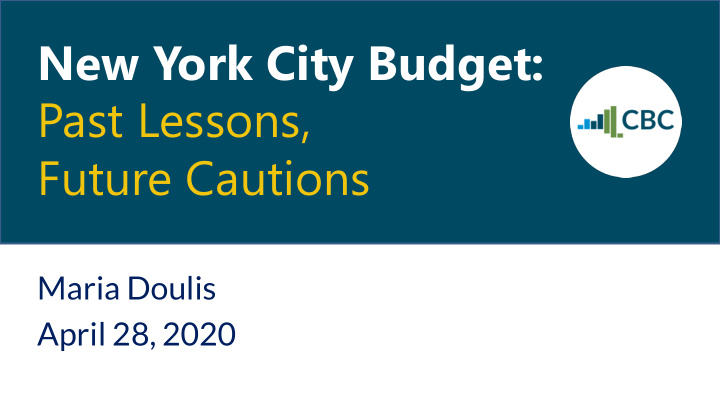



New York City Budget: Past Lessons, Future Cautions Maria Doulis April 28, 2020
About the Citizens Budget Commission • Founded in 1932 • Funded by Trustees who represent New York City economic sectors • Nonprofit, nonpartisan, nonideological • New York State and City budget watchdog • Think tank that produce evidenced-based recommendations to improve services and finances 2
Two Key Points • Resiliency: New York City has faced other “unprecedented crises” and emerged stronger for it by planning for the future • Shared Sacrifice: New York City has managed fiscal shocks through a combination of expense cuts, tax increases, workforce concessions, and sometimes, borrowing 3
Presentation Overview • City budget benefited from a long economic expansion, but not enough done to save for a rainy day • While the length and severity of the economic disruption remains unclear, even mild recessions have multiyear fiscal impacts • NYC Executive Budget, released last week, does not do enough to get ahead of the multiyear problem • Past wisdom indicates NYC leaders need a balanced gap- closing plan and to look to the City’s future instead of preserving past practices 4
Decade-long Economic Expansion Bolstered City Taxes Federal All Other 7% 2% Other City State Resources Personal 16% +1 million jobs 8% Income Tax, 21% since 2009 trough Other Sales Tax, Taxes 13% 35% Property $1.3 trillion Business Tax Taxes, 9% Property market value 32% Other Taxes, 9% 5
City Budget and Workforce Grew NYC Municipal Workforce NYC Budget Growth (dollars in billions) $98 333,859 $73 $70 297,349 $54 Total City Total City FY2014 FY2020 2014 2015 2016 2017 2018 2019 2020 Additional Positions: 36,510 City-Funded Ann Growth Rate: 5% Change: 12% Avg. Ann. CPI-U Change: 1.3% 6
Savings Outweighed by Spending Reserves $1.25 billion Retiree Health Benefits Trust $4.6 billion 7
The Current Crisis 8
NYC Executive Budget for FY2021 FY2021 budget is balanced Revenue Shortfall with: FY20 FY21 FY22 FY23 – Reserves and federal ($1.2) aid ($2.6) ($3.1) – Funds from the RHBT ($5.4) – A savings program with minor expense cuts; few recurring savings 9
The Fiscal Cliff Budget Gaps (dollars in billions) FY2021 FY2022 FY2023 FY2024 $0.0 ($4.5) ($4.9) ($5.0) 10
Overcoming Fiscal Shocks Requires strong fiscal management and a “package” of policy • proposals; shared sacrifice between residents, taxpayers, and workers In addition to reserves, in prior crises NYC relied on: • – Increased intergovernmental aid – Expense cuts, often necessitating service reductions or layoffs – Contributions from the workforce – Tax increases – And in most severe cases – Fiscal Crisis and 9/11 – borrowing for operating purposes 11
Intergovernmental Aid • More State aid cuts on the way • NYC received substantial federal aid after 9/11 and Great Recession, but is unlikely to be favored in any future federal action • Federal aid did not and will not close the gaps, even in a single year 12
Expense Cuts IMPROVE EFFICIENCY REDESIGN OR ELIMINATE CUT SERVICES COST-INEFFECTIVE IMPLEMENT HIRING FREEZE IMPLEMENT LAYOFFS PROGRAMS PAIRED WITH ATTRITION A VOID SHORT - SIGHTED CUTS 13
Collaboration with Labor ▪ Reconvene committee to NYC Expenditures address rising health insurance costs; implement premium- Salaries sharing and Wages, $30.9, ▪ Collaborate to identify and 32% change workrules needed to make operations more efficient Other Pensions, Fringe $9.9, 10% Benefits, ▪ Furloughs, wage freezes, $11.8, 12% layoffs 14
Tax Increases • Tax changes require State approval; one exception is property tax • Other taxes capable of raising significant revenue: personal income tax and sales tax • Cautions: – May not generate expected revenues as economic activity on “pause” rather than slowed – Federal tax policy changes (SALT cap) have put NYC at a competitive disadvantage 15
Borrowing • Borrowing for operations led New York City to the verge of municipal bankruptcy in 1970s • Borrowing has only been used in times of extreme crisis: to restructure city gov’t after 1975 fiscal crisis and after 9/11 • Pushes costs to future New Yorkers and trades off against future service delivery • Should be last resort 16
Concluding Thoughts • Strong fiscal management is important to the City’s continued success • Crisis is opportunity for the City to reinvent economy and services • Options should for gap-closing should be weighed with an eye toward protecting the City’s attractiveness as a place to live, work, and visit 17
Thank You Questions? Email: mdoulis@cbcny.org Twitter: @mariadoulis @cbcny Podcast: What’s the Data Point? Website: www.cbcny.org 18
Recommend
More recommend